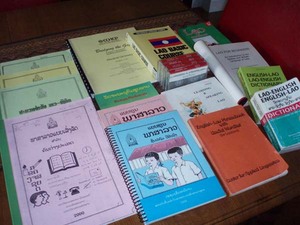About two years ago I set out to learn the language of Laos. Having visited there in 2006 I fell in love with the people, the culture, the food and the language. Lao is spoken by a relatively small percent of the world’s population. It is the official language of Laos, along with being spoken by many of the Issan people in Thailand’s Northeast. In the United States you will find certain states with a high concentration of native Lao speakers, such as in California, Texas, Minnesota and my state; Rhode Island.
Learning a foreign language is never an easy challenge. In the end you need to eat, breathe and sleep that language. For many of the more common languages, it’s a simple trip to the bookstore or library and you’ve got an armful books, CDs… Maybe even Rosetta Stone software. I quickly learned that with Lao, resources for learning are few and far between outside of Laos. The following resources I have found to be very helpful on the journey into to the language of Laos.
SEAsite Laos
SEAsite Laos is an online self-study program. It is part of the Center for Southeast Asian Studies at Northern Illinois University.
SEAsite Laos is by far the most comprehensive online resource for learning the Lao language. It can be a little difficult to navigate your first time visiting, but it is truly a wealth of information. A good place to start is the Introduction page: http://www.seasite.niu.edu/lao/LaoLanguage/spoken_lao/spoken_lao_in_the_new_millennium.htm to learn a little about how Lao relates to the Tai (not Thai) family of languages. Another important step is to make sure you download all the font files to be able to properly view the site. Available here: http://www.seasite.niu.edu/Lao/LaoLanguage/LaoWritingSystem/LaoWritingSystemFP.htm
I would next recommend starting with the Spoken Language Lessons. http://www.seasite.niu.edu/Lao/LaoLanguage/spoken_lao/spokenlao.htm
Comprised of 30 lessons; each lesson has MP3, vocabulary, grammar and pronunciation files available for download.
I found burning a CD of the MP3 files and listening to them during my daily commute was very helpful ; just to have the language “in my head”.
As I said, SEAsite provides a wealth of information but it is by no means all-inclusive. The next thing you will want to acquire is a good dictionary. In my humble opinion, there are three worth purchasing.
My favorite and most worn-out copy is: Lao-English English-Lao Dictionary for Non-Lao Speakers
by Khamphan Mingbuapha; Benjawan Poomsan Becker. It’s divided into three sections: English-Phonetic-Lao, Phonetic-Lao-English and Lao-Phonetic-English. At 780 pages it has most of the basic vocabulary you will need when beginning to learn Lao. It also includes a very well written guide to pronunciation explaining some of the unique characteristics of the Lao language (tones, transliteration, tone marks, Lao script etc.)
My second favorite dictionary is English-Lao/Lao-English Dictionary (Revised Edition)
by Russell Marcus. This dictionary is set up very similar to the one above. I own several editions of this dictionary as it seems to have been revised quite a bit over the years. I find it a little harder to read the Lao script in this dictionary, but it is still one of the most comprehensive dictionaries you’ll find. It’s helpful for locating words that might not be included in the Mingbuapha and Becker dictionary.
Another handy book to own is the Lonely Planet Lao Phrasebook. Besides my Lao Dictionary, this is the other Lao book I carry around with me whenever I am going to be with Lao speakers. Categorized in standard Lonely Planet Phrasebook fashion, it’s helpful when you want to respectfully call your friend’s father “grandfather” but aren’t sure the proper way to do it. (See the subheading “Forms of address”.) It actually has a surprisingly good section on Grammar, which covers basics such as nouns, word order, verbs, to be, classifiers and prepositions in a way that I found simpler to understand than SEAsite.
Another helpful resource is the book/CD combination Lao for Beginners
by Buasawan Simmala; Benjawan Poomsan Becker. I would recommend this book if you’d like something a little less “meaty” than SEAsite. It’s a friendly, well written book that adequately covers a basic range of topics from greetings to body parts in 10 lessons. I think this is the perfect book for classroom use, assigning a lesson each class. It also has practice pages for getting the hang of writing in Lao script.
If by this point you still just can’t get enough Lao language learning materials there is the Foreign Service Institute Lao Language Course. Developed in 1974 by the United States Government, it is now in public domain. The entire course (a 474 page text book .pdf file and almost 80 hours of instruction) can be downloaded at no charge here: http://www.fsi-language-courses.com/Lao.aspx My tip on the student text file is email it to Kinko’s or another copy shop to have printed and bound for you. It should cost around $14.00, depending on what copy shop you use.
Of course, all the study in the world won’t help unless you practice your new language skills!
Practice ideas:
If you live in an area with a sizeable Lao population, take advantage of it! Visit the restaurants (a surprising number of Thai restaurants are actually Lao owned), Asian markets, “a-nii meen nyang” (what’s this?) is a very simple yet helpful first phrase to know.
Another idea, form a study group. Are there others in your area who wants to learn Lao? I used to host “Lao Language and Culture Nights”. A small group of us learners would gather, snack and study together. We’d cover lessons from SEAsite or we’d work on vocabulary lists. (100 most common words, greetings, weather, gardening …etc.)
There is not an active group yet, by maybe consider starting a Lao Meet-up group in your area.
www.meetup.com Meet and network with others interested in Laos and the Lao language.
Try to find a native speaker as a tutor. This is invaluable. Ask around at the market if they know anyone who would be willing to spare an hour every week to tutor you. You could even try posting an ad on Craigslist. Offer to pay them of course!
Listen to Lao programs. I like Voice of America – Lao. http://www.voanews.com/lao/ Find Lao movies (there are not that many) A new one recently came out this past year “Sabaidee Luang Prabang”. You can purchase it at www.ethaicd.com or watch it in 10 minute increments on www.Youtube.com
Above all else, maintain a sense of humor. Learning a new language is a challenge, accept the fact you will make mistakes. However, eventually, you’ll notice you start thinking in the language. The Lao script will begin to feel familiar, less foreign and you’ll be on your way to speaking like a native Lao!








